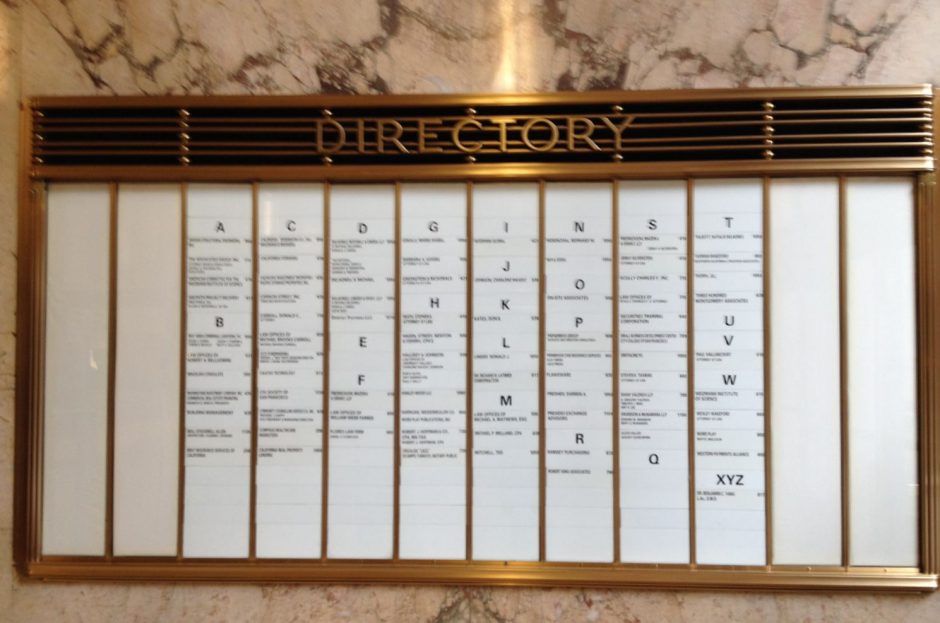
Preserving Design and Simplifying Service
A Renovation Problem
When a lobby renovation on a historical building in San Francisco’s Montgomery Street district recently began, it was noticed that one particular item needed a unique renovation, the name strip directory, which had been installed in 1917 by The Tablet and Ticket Company. Tablet and Ticket had not only built the original building directory but had also serviced it for the last 97 years. Though the design of the old building directory complimented the architecture of the building and interior lobby area, it was inconvenient to change names, requiring removal of the back panels to get to the name strips. The lettering on the name strips was also small and not as legible as with contemporary models.
Was there a way to retain the classic design, but make the directory easier to service and the name strips more legible? The architects handling the lobby renovation contacted Tablet and Ticket. Thankfully, they were able to step in and assist on the original building directory.
The Building
The referenced building was built in 1917 in a neoclassical style with massive stone columns surrounding the ground floor, and a lobby adorned with bronze doors, marble floors and walls, and soaring ceilings. It is located in the city’s financial district, just blocks from the bay, and now houses commercial businesses.
The Directory
 The cast bronze frame on the original building directory complimented the neo-classical style of the building. The beveled glass and even the lettering in the directory was harmonious with the other interior signage in the lobby. Each column had a removable back panel for changing name strips. An easier way to change the name strips was needed.
The cast bronze frame on the original building directory complimented the neo-classical style of the building. The beveled glass and even the lettering in the directory was harmonious with the other interior signage in the lobby. Each column had a removable back panel for changing name strips. An easier way to change the name strips was needed.
Originally, the name strips were made with each individual character being put on a press, stamped out of paper placed over fiber strip, gummed, dried, and then put in the directory.
The Retrofit Process
 There were three goals in the retrofit process:
There were three goals in the retrofit process:
- To retain the design of the era to compliment the building and interior signage,
- To retrofit the building directory to make it easier to service, and
- To develop new name strips that were more legible.
 Tablet and Ticket put in brass dividers between the columns, rebuilt the back and the front so that it was serviceable from the front glass door. They also made new, highly legible name strips, using laser cut signs in a black background with gold text.
Tablet and Ticket put in brass dividers between the columns, rebuilt the back and the front so that it was serviceable from the front glass door. They also made new, highly legible name strips, using laser cut signs in a black background with gold text.
Tablet and Ticket was able to preserve the overall look and keep the frame that was built in 1917.Building directories like that are not made anymore. It could have easily cost $20,000 – $30,000 to build a new one with the historical look.
Other RetroFitted Building Directories
Some historical buildings install a computerized directory when renovating. Others stay with the older style building directory. A retro-fitted directory retains the historical look that a computerized directory doesn’t have. The older, non-illuminated directories are very reliable, having no components that will fail. More people have visibility of the directory at one time than would be possible with a computerized directory. The older directories are also a prestigious form of advertising for firms, denoting a level of expertise that can’t be communicated digitally.
Tablet and Ticket has retrofitted building directories in other cities as well—New York, Boston, Chicago, Washington D.C, and Detroit (the Fisher Building, Albert Kahn Building, in Art Deco style, and Cadillac Place—all on the National Register of Historic Places). They retrofit directories that they have built as well as those built by other companies.
 A poorly converted directory will have newer components mixed with the historical frame—resulting in a cheap appearance that detracts from the beauty of the historical design and from its surroundings. A properly retrofitted building directory preserves the beauty of the original design and improves the convenience of servicing the unit. Retrofitting building directories is best done by a company that has the expertise to customize the project, understanding the newest techniques to apply and what elements of the original design should be maintained. Contact us with any questions on retrofitting building directories, or with questions about custom architectural signage.
A poorly converted directory will have newer components mixed with the historical frame—resulting in a cheap appearance that detracts from the beauty of the historical design and from its surroundings. A properly retrofitted building directory preserves the beauty of the original design and improves the convenience of servicing the unit. Retrofitting building directories is best done by a company that has the expertise to customize the project, understanding the newest techniques to apply and what elements of the original design should be maintained. Contact us with any questions on retrofitting building directories, or with questions about custom architectural signage.









